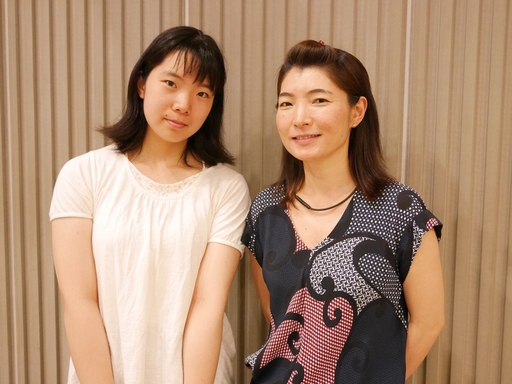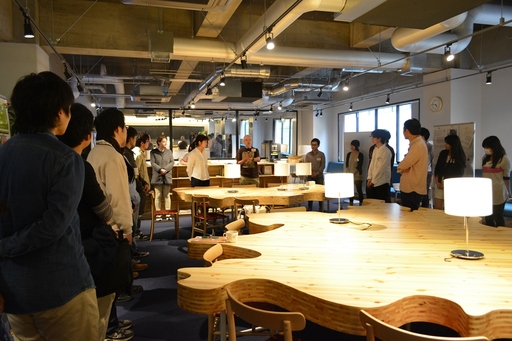ELSI Blog
58 Building and Strengthening the Bridge between ELSI and Students
 Chie Kato is in Hirose Lab, a 2nd year Masters course student at the Dept. of Earth and Planetary Sciences. Hanako Ricciardi is the Coordinator of International Initiatives at ELSI.
Chie Kato is in Hirose Lab, a 2nd year Masters course student at the Dept. of Earth and Planetary Sciences. Hanako Ricciardi is the Coordinator of International Initiatives at ELSI.
Hanako Ricciardi (HR): In the past few blogs, we have posted entries from Tokyo Tech students who wrote after attending a welcoming event that we held for them at the institute. We all know and firmly believe that students are integral to the goals of ELSI, not only the scientific ones but also our funding mandate that we improve and reform the environment for conducting interdisciplinary and international scientific research.
Although slowly improving, we have not managed to break the ice on more free-flow student interactions with ELSI members. The students connected to ELSI through our PIs tended to worked in their associated labs and did not spend much time interfacing in the free spaces or join in the activities at the institute. Beyond those already connected to ELSI, we are on a campus surrounded by a sea of students. Yet, we did not see and could not entice much student traffic into our building. Students are, by and large, extremely busy at Tokyo Tech. But even still, we need to be doing better in letting them know and take advantage of our open doors.
Like many things in life, what gives us our strengths is also what often impedes our progress. The foundational literacy in science and math is very high at Tokyo Tech. We get some of the best students and the Japanese education system prepares for that well. The Japanese system in which almost all students stay in the same university from undergraduate to doctorate helps build strong research labs, especially where expertise through familiarity of operating the instruments is an asset. On the flipside, this does present its weaknesses. Students may be more timid about venturing out to new circles of exchange, simply out of a reinforced general tendency to physically and mentally stay focused on one's usual territory rather than wander out. On top of that, ELSI's day-to-day language is English, which acts as another possible psychological deterrence for interaction.
But just because things are the way they are does not necessarily mean that people are happy with the situation. An opportunity for ELSI to improve its interactions with students actually came from a student, a case in point to the power of students!
I will let 2nd year graduate student Chie Kato introduce herself and then tell us about what led her to suggesting the welcoming party event.
Chie Kato (CH): My study field is deep Earth structure and evolution. I am working on high pressure experiments using diamond-anvil cells in Hirose-san's lab. I am interested in high pressure experiments because it can make constrains on the non accessible, but huge part of the Earth.
ELSI and the Department of Earth and Planetary Sciences (EPS) at Tokyo Tech have a close relationship in their research and their members. Students in ELSI associated laboratories including myself have been involved with ELSI. Since last year, our laboratory moved into the renovated ELSI building so we could easily attend the seminars at ELSI and have the opportunity to discuss with ELSI members and guests.
But what about students in other laboratories? It seemed that they didn't know much about ELSI. They also felt an invisible wall. I also noticed that there was no communication between EPS and the biochemistry students which was a pity.
I always felt that more communication and interaction between ELSI and students would be important for each other to expand our knowledge and give a chance for collaborations.
In March this year, we had a poster session at the 2nd ELSI International Symposium where we engaged in active discussions with ELSI members and other people beyond our field of specialization. All the students found it very exciting. This was an event that was structured and we could easily join.
Around this time, Prof. John Hernlund and I discussed how to enhance communication between ELSI and EPS students. I suggested an official event in a casual atmosphere like the one at the symposium poster session. He strongly supported the idea and set up the plans on ELSI's side and I helped to pass the news to other students.
Some EPS students, especially the junior ones, felt that their English was not good enough. The welcoming event and other ELSI interactions can only be helpful to provide a chance for them to get used to communicating in English.
HR: In reality, the students' English abilities were far better than they believed it to be. We were so impressed and now cannot accept the language barrier as a reason! This shifts the responsibility on ELSI in a way, to correct the sense of inaccessibility. The students improving their level and comfort with English is crucial in their future scientific careers. If ELSI can provide the place for 'practice makes perfect' then we should support it.
CK: We asked the students to volunteer to display their posters to break the ice. The plan of talking frankly in a casual way with food and drinks seemed good. The purpose is to get to know about each other and break the barrier.
We had enough students sign up but on the actual day, many more students and ELSI members attended than I had expected. We were very happy to see Biochemistry students come from the other Tokyo Tech campus. The PIs were supportive of making the announcement to their groups. We thought we had ordered extra food but all the pizzas, beer and drinks were gone so fast!
I appreciate Prof. Hernlund and all the ELSI members for holding such a great event for us students. It made ELSI more familiar and more accessible to us. I think this Student Welcoming Event will trigger more active interaction between ELSI and students and hopefully lead to future collaborations.
HR: We could not have reached as many students without the help of an effective student representative as Chie Kato so we are thankful to her. I also want to thank John Hernlund for taking Chie's idea and turning it into action. We would like to host such an event a few times a year. It will only be easier going forward. And we will make sure to have more pizzas and drinks - I forget how hungry students are!
To come back to why ELSI as an institute values student involvement, PI Piet Hut put it nicely:
"The most important aspect of student involvement is to let students see how actual top-level research is done -- not a restaurant view as in conferences and workshops, but a kitchen view, where they can see what is simmering, and also what occasionally drops on the floor, breaks, or simply is discarded because the dashi (base soup stock) wasn't quite right."
Hut continues, "This kind of participation is not a favor from older scientists to younger scientists, it is an essential investment to guarantee that the next generation gets a flying start, the best preparation possible to become the best scientists they can with optimal chances to develop their full potential. Especially in Japan, with the root-learning tradition of education, this is an essential complement."
And the benefit goes to the senior scientists as well. The students will do the legwork/homework of running with ideas given by their mentors who are far busier than they. A senior scientist can suggest to graduate students, especially beginning graduate students, to spend, say, a few weeks on a specific well-defined project, to read up on some papers, and then to try and find some more papers by starting from the papers suggested by the senior scientist. If the senior scientist then suggests a specific question, the student might come up with suggestions that the older scientist had not thought of; this can be suggestions stemming from his/her own ideas, and/or ideas that he/she found in the literature. Because students have far more time than senior scientists, even talking for fifteen minutes, once a week, the older scientist can guide, and the younger student can gather, both ideas and data from the literature.
For a multi-disciplinary institute like ELSI, students may be able to better provide the flexibility and open-mind for interdisciplinary research, perhaps unencumbered yet of their discipline's habits, and act as the collaborative link between the disciplines.
At the end, the relationship between students and ELSI members is a win-win situation. And we expect nothing less than great work in the future from their involvement.
Thank you to Chie and all the students who wrote blogs, who came to the welcoming event and shared their research and presence with us.












